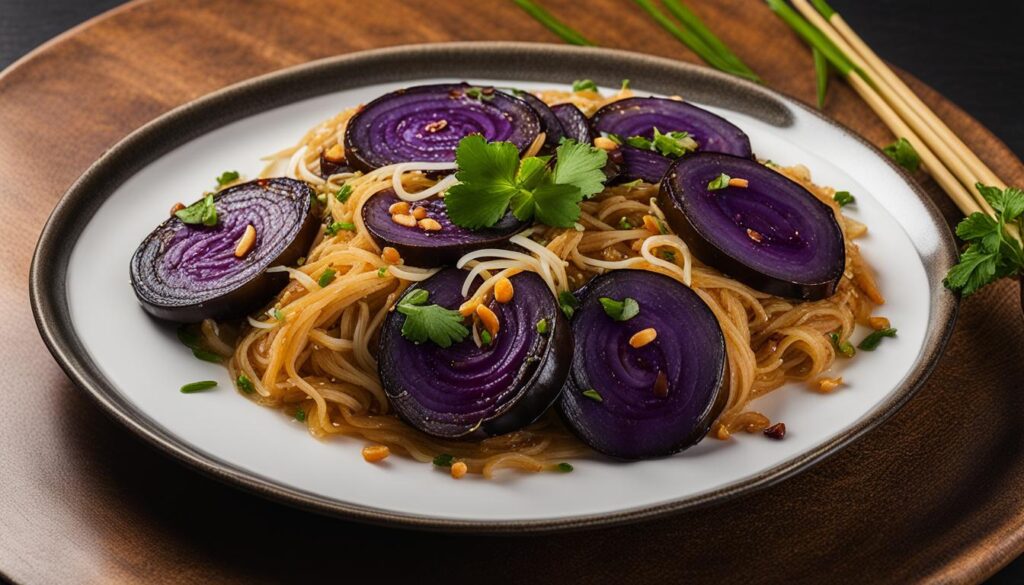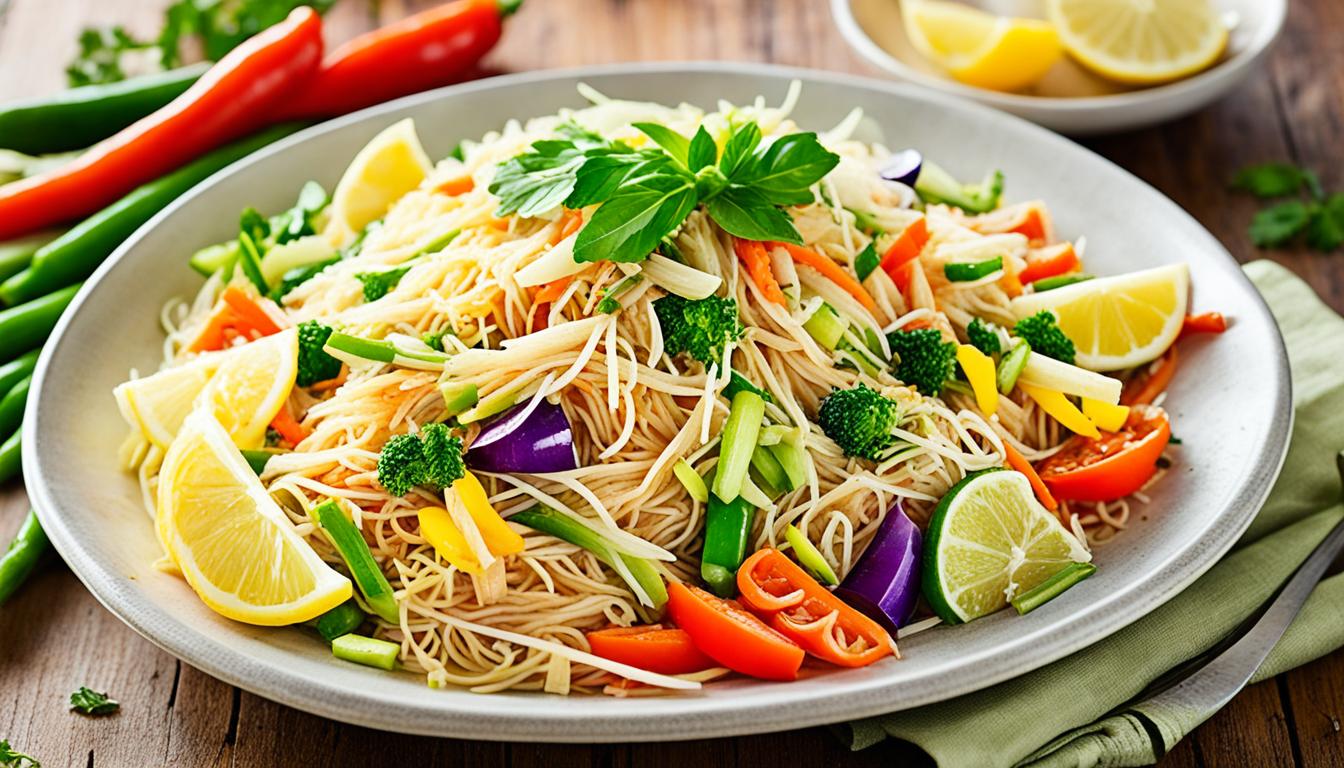Are you ready to embark on a flavorful journey to the Philippines? Get ready to indulge in the authentic taste of Pancit Bihon, a beloved Filipino dish made with delicate rice noodles, savory meats, and vibrant vegetables. But here’s the burning question: What makes this traditional pancit bihon recipe so irresistible?
Discover how to make this classic dish with our step-by-step guide and unlock the secrets to creating a truly memorable culinary experience. From the essential ingredients to the timeless cooking techniques, we’ll show you how to whip up a mouthwatering pancit bihon stir-fry in just 25 minutes. Get your chopsticks ready and prepare to savor every delectable bite!
What is Pancit Bihon?
Pancit Bihon is a popular Filipino dish that showcases the vibrant flavors and textures of Filipino cuisine. This delectable dish is made with a base of noodles, specifically bihon noodles, which are thin rice vermicelli noodles. Cooked with soy sauce, a variety of meats, and an assortment of chopped vegetables, Pancit Bihon is a delightful balance of savory, umami flavors and satisfying textures.
The term “pancit” refers to noodles in Filipino, and the dish has its roots in the Chinese street food culture. Historically, Chinese street vendors cooked Pancit Bihon to cater to the women working in cigar factories during the Spanish colonial times. The dish quickly gained popularity due to its convenience and flavors, becoming a staple of Filipino cuisine.
Today, Pancit Bihon is prominently featured on festive occasions, such as birthdays, weddings, and family gatherings. It is also a beloved comfort food enjoyed on ordinary days. This Filipino favorite is cherished for its ability to bring people together and create lasting memories.
The Versatility of Pancit Bihon
One of the appealing aspects of Pancit Bihon is its versatility. While the dish traditionally includes meat, such as chicken or pork, and a medley of vegetables like cabbage, carrots, and green beans, it can be customized to suit individual tastes and preferences. Vegetarians can omit the meat and load the noodles with an abundance of flavorful vegetables, making it suitable for meat-free diets.
Moreover, Pancit Bihon can be enjoyed as a standalone dish or paired with a variety of side dishes, adding even more diversity to the dining experience. Whether it’s the delightful crunch of lumpia (Filipino spring rolls) or the refreshing flavors of a crisp green salad, the possibilities are endless when it comes to complementing Pancit Bihon with other dishes.
Preparing Pancit Bihon at Home
Making Pancit Bihon at home is a gratifying culinary adventure that allows you to tailor the dish to your liking. With readily available ingredients like noodles, soy sauce, meat, and vegetables, you can create a flavorsome and satisfying meal in no time. The cooking process typically involves stir-frying the noodles with the sauce, meat, and vegetables until they are cooked to perfection.
If you’re eager to try your hand at crafting this Filipino classic, our detailed Pancit Bihon recipe will guide you through each step, ensuring that your homemade version rivals the delectable flavors found in the best Filipino restaurants.
Pancit Bihon vs Pancit Canton
When it comes to Filipino noodle dishes, Pancit Bihon and Pancit Canton are two well-loved variations. The key distinction between the two lies in the type of noodles used. Pancit Bihon features bihon noodles, which are thin rice vermicelli noodles that provide a delicate texture to the dish. On the other hand, Pancit Canton utilizes flour stick noodles, known as pancit canton noodles, which are pre-fried wheat-based noodles offering a heartier bite.
While both variations share similarities, such as incorporating a medley of vegetables and meats, the choice of noodles significantly impacts the flavor and overall experience. Bihon noodles have a lighter and more delicate taste, perfectly complementing the sweet and savory flavors of the dish. Flour stick noodles, on the other hand, bring a slightly richer and chewier element to Pancit Canton.
It’s worth noting that Pancit Palabok is another classic Filipino noodle dish that involves rice stick noodles, wherein it is generously smothered with a luscious shrimp gravy. Noodles, in general, play a significant role in Filipino cuisine and are often associated with symbolizing long life, making them a staple dish at birthday celebrations and other special occasions.
Ingredients for Bihon Pancit
If you’re excited to try out this flavorful Filipino dish, here are the key ingredients you’ll need to make Bihon Pancit:
- Peanut oil: Start by heating up some peanut oil in a large skillet or wok. The nutty flavor adds a delicious dimension to the dish.
- Chicken breast: Slice boneless, skinless chicken breast into thin strips. It provides a protein-packed element to the dish.
- Garlic: Finely mince fresh garlic cloves to infuse a delightful aroma into the stir-fry.
- Onion: Slice a medium-sized onion to add both sweetness and texture to the dish.
- Bihon noodles: These thin rice vermicelli noodles are the star of the show. They soak up the flavors of the sauce and veggies.
- Mixed vegetables: Grab a colorful array of mixed vegetables like green beans, carrots, and cabbage. They add crunch, nutrients, and vibrant colors.
- Pancit sauce: Make a flavorful pancit sauce using low-sodium chicken stock, dark soy sauce, regular soy sauce, oyster sauce, and a touch of sugar. It brings together the umami flavors.
- Salt and pepper: Season the dish with salt and pepper to taste. Adjust the amounts to suit your preferences.
These ingredients combine to create a harmonious balance of flavors, textures, and colors in Bihon Pancit. The eventful marriage of sautéed chicken, perfectly cooked noodles, and a medley of fresh vegetables makes this dish a true Filipino delight.
How to Make Bihon Pancit
To make delicious Bihon Pancit, follow these simple steps:
Step 1: Prepare the Sauce
- Whisk together all the ingredients for the sauce, including low-sodium chicken stock, dark soy sauce, soy sauce, oyster sauce, and sugar. Set the sauce aside.
Step 2: Pan Fry the Chicken Breast
- Heat a pan over medium heat and add a small amount of oil.
- Season the chicken breast with salt and pepper, then pan fry until fully cooked.
- Remove the chicken from the pan and set it aside.
Step 3: Sauté Garlic and Onion
- In the same pan, add garlic and onion. Sauté until they become fragrant and golden brown.
Step 4: Add Chicken and Mixed Vegetables
- Return the cooked chicken to the pan.
- Add the mixed vegetables, such as green beans, carrots, and cabbage.
Step 5: Incorporate the Sauce
- Pour the prepared sauce into the pan with the chicken and vegetables.
- Bring the mixture to a boil, ensuring all the ingredients are well-coated with the sauce.
Step 6: Cook the Bihon Noodles
- Add the bihon noodles to the pan, stirring them into the sauce.
- Cook the noodles in the sauce until they become tender, absorbing all the flavors.
Your Bihon Pancit is now ready to be served! Garnish with soy sauce and lemon wedges for an extra burst of flavor.
Vegetarian Bihon Pancit
Looking for a vegetarian option of the classic Pancit Bihon? You’re in luck! This versatile dish can be easily adjusted to suit your dietary preferences. By omitting the chicken, you can create a delicious vegetarian version of Pancit Bihon that is packed with flavor and nutrients.
You can load your vegetarian Bihon Pancit with a variety of colorful vegetables such as carrots, cabbage, green beans, and scallions. These vegetables not only add vibrant flavors but also provide essential vitamins and minerals. Feel free to experiment and add other vegetables of your choice to create your perfect vegetarian Pancit Bihon.
If you’re a pescatarian, you can also consider adding shrimp as an alternative option to chicken. Shrimp adds a delicious seafood twist to the dish while still keeping it light and healthy.
Customizing the recipe to suit your taste and dietary needs is what makes Pancit Bihon so enjoyable. Make it your own by incorporating your favorite vegetables and alternative protein options!
What to Serve with Filipino Bihon Pancit
Filipino Bihon Pancit is a flavorful dish on its own, but you can take your meal to the next level by pairing it with delicious Asian side dishes. These side dishes not only add variety to your plate but also complement the flavors of Pancit Bihon, creating a well-rounded dining experience. Here are some popular options:
1. Chinese Eggplant with Garlic Sauce

Chinese eggplant with garlic sauce is a delectable side dish that brings a burst of flavors to your meal. Sautéed eggplant pieces are coated in a savory garlic sauce, creating a perfect balance of sweetness and spiciness.
2. Dry-Fried Green Beans
Dry-fried green beans are a delightful side dish that adds a crunchy texture and vibrant green color to your plate. The green beans are stir-fried with garlic and seasoning until they’re slightly charred, resulting in a flavorful and addictive side dish.
3. Smacked Cucumber with Chili Oil
For a refreshing and spicy side dish, smacked cucumber with chili oil is an excellent choice. The cucumbers are lightly crushed to release their flavors, then marinated in a spicy chili oil dressing, creating a tangy and zesty accompaniment to your Pancit Bihon.
4. Chicken Egg Foo Young
If you’re looking for a heartier side dish, chicken egg foo young is a perfect option. This Chinese-American dish features fluffy omelet-like patties made with beaten eggs, chicken, and a variety of vegetables. It pairs well with Pancit Bihon and adds satisfying protein to your meal.
5. Green Salad with Japanese Ginger Dressing
For a lighter and refreshing side option, a green salad with Japanese ginger dressing is a great choice. The crisp mixed greens are topped with a tangy and slightly sweet ginger-based dressing, creating a refreshing contrast to the flavors of Pancit Bihon.
These side dishes are just a few examples of the many options you can pair with Filipino Bihon Pancit. Feel free to explore and experiment with different flavors and textures to create a meal that suits your taste preferences.
Excellent As Leftovers
Don’t let any leftover Pancit Bihon go to waste! This delicious dish is perfect for saving as leftovers and enjoying for another meal. Simply store it in an airtight container in the refrigerator, and it will stay fresh for up to four days. If you have more leftovers than you can finish, you can also freeze them for later. Just make sure to use freezer-safe containers or bags to keep the flavors intact.
When it’s time to reheat your Pancit Bihon, there are a few tricks to keep in mind. To prevent the noodles from drying out, cover them with a lid or a damp towel before reheating. For a quick and convenient option, you can use the microwave. Heat the dish for a few minutes, stirring occasionally to ensure even heating. Alternatively, you can steam the leftovers, which helps to preserve the flavors and textures of the dish.
Remember, proper storage and reheating techniques are key to enjoying the full deliciousness of your Pancit Bihon. So whether you’re craving a midnight snack or planning a quick lunch, you can rely on the convenience and versatility of this dish.
